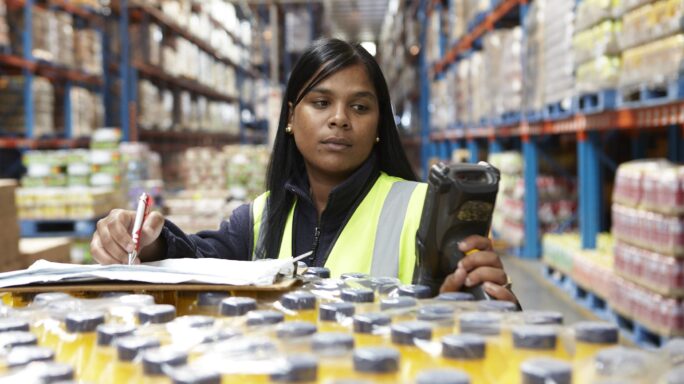Technology & Innovation
How tech, data and the circular economy can help businesses with ESG requirements
Learn about metrics to use when reporting on environmental, social and governance efforts, and the role tech can play.

Have you been given the task of reporting on your company’s sustainability efforts but not sure where to begin?
Or are you feeling cautious as you’re keen to ensure your business doesn’t fall foul of greenwashing accusations?
In this article, we look at choosing metrics and reporting on environmental, social and governance (ESG) efforts, how tech can play a key role, and why the circular economy can help with sustainability.
Here’s what we cover:
- How sustainability efforts can go wrong
- How should you report on your efforts?
- What are your metrics?
- How a hotel chain reports on its ESG data
- What tech should you use to be more sustainable?
- The circular economy can help with your ESG goals
- How to overcome your operational hurdles
- Final thoughts: Get real with ESG
How sustainability efforts can go wrong
You’ve probably noticed many businesses pushing how good they are with sustainability.
And while that might be true for most brands, things are not always as green as they seem.
You can make bold claims about sustainability but you need to be able to back them up, because everyone from potential investors to partners, employees and customers could ask for proof of your efforts.
Some brands might confuse, upset, or even anger eco-aware customers by claiming they’re sustainable without backing it up with evidence.
How should you report on your efforts?
To avoid claims of greenwashing and meet ESG demands, you need to back up your claims with data. You need evidence of your ESG efforts that everybody can see.
Investors, stakeholders, and eco-conscious customers will want to see you’ve successfully hit sustainability targets (or that you’re working hard to achieve them).
Global market intelligence firm IDC adds that you should measure, analyse and report your ESG progress using a standardised framework for reporting.
Currently, ESG measurement is a complex beast, as, unlike financial reporting, there are no clear expectations on format and content.
There are different measurement frameworks, and it’s a case of finding a system that works best for your business.
Some frameworks are industry-specific, while others are focused on climate change.
It’s important to note that the guidelines you’ll find have different requirements and are difficult to compare, which is why there are ongoing calls for a unified standard like you would see in finance.
What are your metrics?
If you’re a CFO or financial director, you have a leading role in deciding what to reveal beyond what you’re obliged to from a regulatory point of view.
As with financial reporting, measuring, monitoring and reporting should start with understanding your specific strategy and purpose. There needs to be a clear link between ESG and your business strategy.
You can track many metrics, but make sure they’re simple, standardised (to allow comparison) and informative.
With ESG measurement, metrics will fit in these key areas:
Environmental
Your environmental footprint could include information about your company’s action against climate change, harmful emissions and greenhouse gases.
Carbon emissions are a measurement of the greenhouse gases you produce, which can help you understand how your business contributes to climate change and identify ways to reduce it.
Another common metric you could measure is your renewable energy share, representing the amount of energy you use that comes from renewable sources, and renewable energy intensity—the renewable energy consumed per unit of output.
Social
This covers how you manage your relationships with employees, suppliers, customers and communities, including details on the likes of health and safety, your labour standards, and relationships.
You could measure the number of your employees volunteering in their local communities and the percentage of the workforce participating in volunteer programmes, for example.
You might even measure your financial contribution to sustainable causes such as environmental protection or poverty alleviation efforts.
Governance
This area covers the quality of company management, how managers are remunerated, audits and internal control, what the transparency of management is like, and so on.
You might, for example, look at the skills and experience of the people that will manage your energy transition.
How a hotel chain reports on its ESG data
Dakota Hotels uses detailed reporting to measure its ESG efforts.
It can collect energy data from various sensors and meters and draw insight using reports and dashboards via financial management software.
“We can present this insight to people in key roles around the business, from the maintenance team to hotel managers,” says Sam Hartley, the company’s finance director.
“The granularity of this information means that we can compare trends, review our electricity costs and consumption, and make adjustments, which benefits both the bottom line and our sustainability credentials.”
Not only can Dakota Hotels meet the needs of its increasingly eco-conscious customer base, the strategy also slashes the group’s energy bills by tens of thousands of pounds annually.
“At a time where costs are under scrutiny, this has been incredibly welcome as both a short-term saving, as well as helping us to meet our long-term sustainability goals,” says Sam.
“As we move increasingly towards renewable energy usage, the system will be crucial in evaluating its value against other sources.”
Dakota Hotels is using technology to save money and improve its ESG credentials, showing that cost benefits from a sustainable strategy are within reach.
What tech should you use to be more sustainable?
Digital transformation can help your business become more sustainable. The challenge is finding the right mix of technology to boost your ESG efforts.
4 key areas of technology can supercharge sustainability
1. Cloud applications and infrastructure to cut your carbon footprint
You can reduce your business’s carbon footprint by moving to cloud systems instead of wasting money on power and physical materials.
Whatever your industry, you can use the cloud to:
- Research, design, and develop products more efficiently and cost-effectively
- Fabricate, manufacture, and analyse sustainable products
- Innovate in areas that support sustainability, such as additive manufacturing (3D printing) and digital twin solutions.
2. Data analytics to power predictive intelligence
You can apply data analytics to:
- Improve sustainable products by refining their development
- Build sustainable supply chains by applying the necessary logistics
- Allocate the right resources, at the right time, with improved product scheduling
- Monitor machine usage and reliability, making your equipment more resource-efficient and sustainable.
3. Automation to change the way you work
Automating could:
- Speed up the way you work
- Boost your productivity
- Reduce human mistakes
- Give you valuable data to improve performance.
4. The Internet of Things (IoT) to connect complex supply chains
Like Dakota Hotels, you can connect sensors to collect the data you need to keep your energy consumption low. You could also detect problems before they happen so your products don’t break down and can be used for longer.
IoT supports:
- Better visibility of supply chains, bringing opportunities for control and innovation
- The ability to create and process data to fulfil complex supply chain demands
- Material tracing, reverse logistics, decentralised production, remanufacturing and blockchain opportunities.
The circular economy can help with your ESG goals
By hitting a sweet spot between environmental and business goals, companies might be motivated to gain energy efficiencies and reduce their carbon footprint. Many organisations have made public announcements around key sustainability goals and timelines, putting in place green policies.
Sage recently conducted a comprehensive survey and analysis, which says business leaders are focusing more on sustainability in the ongoing battle against the destructive effects of climate change.
The results revealed 84% had a role in their sustainability strategy, and 32% said it was central to their job.
If you want to be part of a sustainable, environmentally friendly business, the circular economy can help.
It turns the linear approach of taking, making and disposing into a cyclical model of make, use, return, recycle, reuse and make.
In other words, keeping materials, products and services in circulation for as long as possible, by focusing on industrial processes and economic activities that are restorative or generative by design.
You can cut waste and pollution by rethinking and redesigning how you make products.
If you make progress on your ESG goals, you can achieve broader business objectives, including improving profitability and operational efficiency.
How to overcome your operational hurdles
Here are four steps towards advancing your circular economy strategy and becoming an authentically sustainable business.
1. A transformational mindset
Look for people who are willing to ask questions and do things differently. It’s not enough to run a business as usual, even if you have decent margins and a steady income.
Create a culture that continually challenges the way you do business.
The circular economy needs you to examine why you’re doing things the way you are, where your materials are coming from, and how you build transparency.
2. Generate more data
You need to pull together data across the business and use it well, whether from the financial department or assembly line.
You may still rely on managers to verbally give you information, but data gives you flexibility and agility.
3. Embed IoT
The information you gather from IoT devices can measure the success of circular economy projects, making your business more efficient and intelligent.
4. Choose tech that enables efficiency and innovation
To make the circular economy work, you need to innovate.
That means choosing the right technology platforms, which are the foundation for creating sustainable products. Look for the right building blocks to make your processes more open and agile.
Final thoughts: Get real with ESG
Ask yourself if you have data to prove that your circular economy practices help you with ESG. Do they:
- Make your operations more cost-effective?
- Drive down waste, pollution, and energy use?
- Minimise your use of resources?
Go even deeper into how your business works. Have you increased supply chain security by cutting your use of raw materials? Have you built new business models from renting or leasing used machines and equipment?
Consulting chief information officer (CIO) and technology expert Isaac Sacolick says everybody should pay attention to and promote the circular economy, from boardroom executives to marketing department professionals.
“It goes to the business’s mission and values,” Isaac says. “It brings companies back to the core of what they’re doing for social good and wellness.
“If the chief marketing officer promotes sustainability efforts that require difficult decisions, I can only think it’s a good thing.
“Sometimes, it takes a leader to step up, pave the path and help other executives catch up.”
With the circular economy, transform your business to focus on reuse and recycling, moving away from waste and a linear economy.
Meet ESG demands with profit and purpose, focusing on doing good rather than just looking good. Your path is digital transformation and technology.
Look at your business, change where you need to, and look to the future today.







Ask the author a question or share your advice